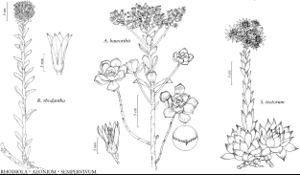Aeonium
Hist. Nat. Îles Canaries 3(2,1): 184, plates 28–35. 1840 ,.
Shrubs [perennial herbs], not viviparous, [1–] 7–10 [–20] dm, glabrous or pubescent. Stems erect, branched [simple], woody or fleshy. Leaves persistent, crowded in rosettes at ends of branches, alternate, sessile, not connate basally; blade oblong-lanceolate or obovate, laminar to terete, 3–15 cm, fleshy, base not spurred, margins ciliate; veins not conspicuous. Inflorescences terminal cymes. Pedicels present. Flowers erect or spreading, [6–] 7–12 [–16] -merous; sepals connate basally, all alike; petals spreading or erect, distinct or nearly so, cream or bright-yellow; calyx and corolla not circumscissile in fruit; nectaries mostly rectangular; stamens 2 times as many as sepals; filaments adnate on corolla base; pistils erect, distinct or nearly so; ovary base rounded; styles 2+ times shorter than ovary. Fruits erect. Seeds ellipsoidal, ribbed, finely cross-ribbed. x = 18.
Distribution
Introduced; Calif., Asia (Yemen), Africa, Atlantic Islands (especially Canary Islands)
Discussion
Species 31 (2 in the flora).
Aeonium and the other polymerous-flowered Macaronesian Crassulaceae were formerly included in the polymerous-flowered Sempervivum. From studies in DNA and molecular systematics, T. H. M. Mes (1995) concluded that Aeonium and these related genera probably evolved from North African Sedum-like ancestors and are only more distantly related to Sempervivum. He thought that the wide range of growth-forms in Aeonium, including the woody habit, is derived from herbaceous ancestors.
Selected References
None.
Lower Taxa
Key
| 1 | Rosette leaves 50-75, blade bright green, 5-9(-15) cm, 1.5-3 mm thick; petals 9-11, spreading, bright yellow. | Aeonium arboreum |
| 1 | Rosette leaves 15-25, blade gray-green, 3-6 cm, 2-5 mm thick; petals 7-9, erect, cream. | Aeonium haworthii |
"dm" is not declared as a valid unit of measurement for this property.
